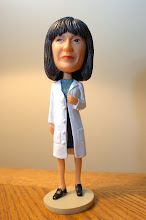Welcome back and sorry for the long delay between posts. I just got back from a great vacation and am ready to continue our discussion about probiotics and prebiotics. If you remember from the last post, probiotics are ingestible microflora that provide benefits to your health. Those bugs need to be fed, which is obviously accomplished by the foods that you eat, but can be enhanced by feeding them their favorite foods - prebiotics.
Prebiotics are non-digestible carbohydrates like fiber. You see these carbs aren't digestible by us, but the probiotics have no problem breaking down these molecules. Some of the products considered to be prebiotics include inulin, fructooligosaccharides, polydextrose, lactitol, resistant starches, corn fiber, and arabinogalactose. In addition to eating foods enhanced with prebiotics, some of these foods are also full of prebiotics: chicory, jicama, bananas, oats, whole grains, onion, garlic, leeks, honey, and artichokes. Fermentable carbs seem to work best, but not all prebiotics work equally with each probiotic.
There is quite a bit of research currently being conducted to determine which prebiotic works best with which probiotic; synergy is important here. Lactobacillus seems to prefer galactooligosaccharides while Bifidobacteria seems to prefer fructooligosaccharides. Scientists really want to find the optimum combinations because early research suggests that these "symbiotics" show great promise in prevention of colon cancers and increase our resistance to infections. In addition, they help increase calcium and magnesium absorption and help with intestinal regularity.
So, I hope you are not completely confused by all the prebiotic/probiotic/symbiotic talk and that you have a better understanding of beneficial bugs and what the food industry is doing to try to make food healthier for you. Keep an eye open for these enriched/enhanced products coming to a grocery shelf near you soon (if you want additional info -go here). And as always, please email me and tell me what topics you'd like to know more about - I'm here to help you become food literate!
Prebiotics are non-digestible carbohydrates like fiber. You see these carbs aren't digestible by us, but the probiotics have no problem breaking down these molecules. Some of the products considered to be prebiotics include inulin, fructooligosaccharides, polydextrose, lactitol, resistant starches, corn fiber, and arabinogalactose. In addition to eating foods enhanced with prebiotics, some of these foods are also full of prebiotics: chicory, jicama, bananas, oats, whole grains, onion, garlic, leeks, honey, and artichokes. Fermentable carbs seem to work best, but not all prebiotics work equally with each probiotic.
There is quite a bit of research currently being conducted to determine which prebiotic works best with which probiotic; synergy is important here. Lactobacillus seems to prefer galactooligosaccharides while Bifidobacteria seems to prefer fructooligosaccharides. Scientists really want to find the optimum combinations because early research suggests that these "symbiotics" show great promise in prevention of colon cancers and increase our resistance to infections. In addition, they help increase calcium and magnesium absorption and help with intestinal regularity.
So, I hope you are not completely confused by all the prebiotic/probiotic/symbiotic talk and that you have a better understanding of beneficial bugs and what the food industry is doing to try to make food healthier for you. Keep an eye open for these enriched/enhanced products coming to a grocery shelf near you soon (if you want additional info -go here). And as always, please email me and tell me what topics you'd like to know more about - I'm here to help you become food literate!





2 comments:
You said:
"Prebiotics are non-digestible carbohydrates like fiber. You see these carbs aren't digestible by us, but the probiotics have no problem breaking down these molecules. Some of the products considered to be prebiotics include inulin, fructooligosaccharides, polydextrose, lactitol, resistant starches, corn fiber, and arabinogalactose."
That's very interesting information. Many people seem to mistakenly think polydextrose is a sweetener, probably because of the "-ose" ending, when in fact it is classified by the FDA as a fat replacer, and it seems to have beneficial properties, as you pointed out. I sure hope so, because I'm including a lot of it in my diet.
Technically polydextrose could be called a sweetener because it is a polysaccharide, but it is more commonly regarded as a fiber. It is non-glycemic and not very sweet (if the sweetness of sugar was a 1, polydextrose would be a 0.18). And the prebiotic properties of this product are beneficial to everyone since it stimulates the production of Bifidobacteria in your gut - so enjoy and be well!
Post a Comment